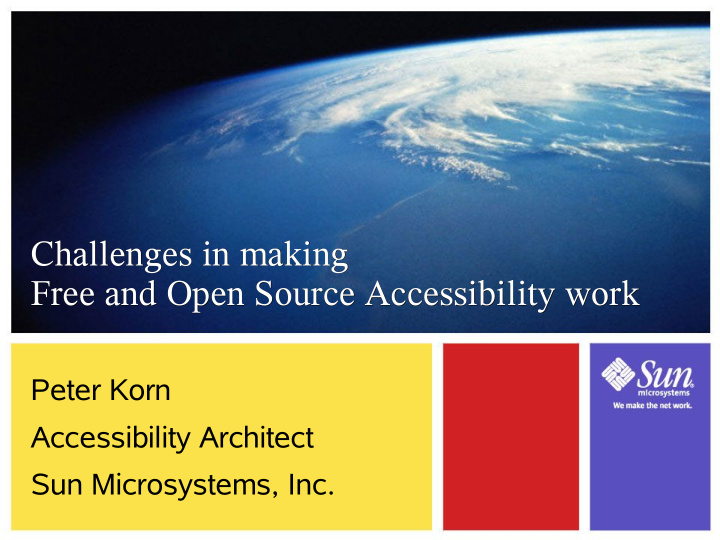



Challenges in making Challenges in making Free and Open Source Accessibility work Free and Open Source Accessibility work Peter Korn Accessibility Architect Sun Microsystems, Inc.
Agenda ● Some History ● Funding model in US, Europe, elsewhere ● Incentives (508, other laws) – what happens when we reach "sufficient support"? ● What are our funding source options?
History ● AT started as small hacks from individuals for individuals ● AT of general use – become products, and companies formed around them ● Big problems (GUI access, Eye gaze, tactile access) got gov't research funding ● Much (most?) purchased by gov'ts, not end users (too expensive to do so!)
Existing funding models ● U.S.: Department of Rehab (maybe) pays for AT software, hardware. Companies pay for employees (“undue burden” clause in ADA) ● Netherlands, Denmark, others: government pays all AT costs for individuals, training costs ● Germany: companies who don't hire individuals w/disabilities taxed – taxes by AT needed by the hired individuals, training costs ● Other countries (help this poor American out here!)
Result of funding models ● U.S.: gov't pays for initial creation, then pays to purchase (pays twice!); private individuals unable to afford the high prices (most disabled unemployed anyway) ● Outside of U.S.: - help me out here gang!
Incentives (laws) ● Section 508: – U.S. Companies working hard to make their desktops (and other products) accesible: ● Sun with GNOME accessibility leadership ● Microsoft with UI Automation ● Apple with “Talking Interface”, Magnifier – Explosion of commercial web accessibility checkers ● IDEA: – School funding for AT purchases
Mandates (laws) ● ADA: – Employers must pay for accommodation where it is “readily achievable” – No real incentive to corporations ● Section 255 of Telecom Act: – Telephones must be accessible in the U.S. (so far this has meant that wireless and cell phones be compatible with hearing aids) – Has had an effect on handset manufacturing, but not for programatic access to phone features beyond POTS
Sun & F/OSS Accessibility ● Sun is here because we believe in it ● Sun is here in a big way because of Section 508 and other laws ● Sun is doing this F/OSS for a few reasons: – We believe in F/OSS, and increasingly more of Sun's technology is going this way (cf. Solaris) – We aren't looking to compete based on unique access solutions – We want the company, and to build community & a viable alternative platform for/around accessibility
What happens after “enough”? ● At some point UNIX & GNU/Linux accessibility will be “good enough”: – Users can be functional, effective on the desktop – U.S. Gov't agencies will be comfortable purchasing under Section 508 – Other governments will be comfortable purchasing ● “Good enough” != “excellent”, “satisfying” – Screen reader scripting needed for “good enough”? – Parity with $1,300 AT needed for “good enough”? – Wealth of AT tools (cf. Windows) needed?
Funding beyond “good enough” ● Where can we go to get funding for F/OSS accessibility (now, and also after “good enough”?) – Companies who otherwise would pay $1,300/screen reader – the Apache model – Gov't agencies who would otherwise pay $1,300/screen reader... – Gov't grants should prefer F/OSS – better benefit to the taxpayers! (how to convince them?) – Universities – technology transfer (cf. GOK, Dasher) – Other ideas? [discussion] ● How do we change these models? [discussion]
Peter Korn peter.korn@sun.com
Recommend
More recommend